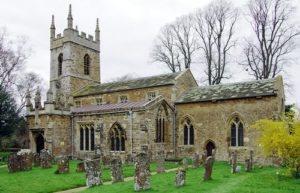South Newington is a small settlement just off the A361, south west of Banbury. There has been a settlement here since Saxon times. The church is built on the high ground, above the River Swere. This was a prosperous area in the Middle Ages and this is reflected in the church.
There is reference of a church here by 1170, although only the font and two Norman arches survive from this church. Around 1290 there was a major reconstruction when the south aisle, most of the north aisle and the tower were added. In the 15thC, the nave roof was raised and a clerestory added.
It is an attractive church with tall square tower with battlements and crocketed pinnacles. It appears lop sided as there is an integral stair turret to the bell chamber.
The nave has a clerestory with lower side aisles. The chancel is lower and has a priests door on the south wall and two bat boxes on the south wall. The impressive porch was added in the 15thC and has a battlemented roof with a lot of pinnacles. There is an empty statue niche above the door and there are carved heads of a king and queen at the base of the doorway arch.
It is similar to so many other Cotswold churches. What makes it unique is the remarkable collection of wall paintings on the north arcade and north aisle. I have written a detailed review of the paintings here.
There are steps into the church. The plain glass windows flood the church with light. Our eyes were immediately drawn to the Norman arcade with its round pillars with carved capitals and round arches. Above the arches is a remarkable sequence of 15thC wall paintings depicting the Passion of Christ. These are presented as a cmic strip cartoon and are delightful. The south arcade is later and has pointed arches with no paintings.
The north aisle was originally the chantry chapel of the Gifford family and is covered with 14thC wall pairings. These include the martyrdom of Thomas a Becket and the execution of Thomas Plantagenet, second Earl of Lancaster for his role in the execution of Piers Gaveston, favourite of Edward II. There is also an Annunciation scene.
It is a simple church. At the back of the church is a Norman tub font with chevron carving round the top. The pews date from 1825 and are numbered. There is a board on the back wall explaining that of the 224 seats 186 are declared to be free and unappropriated for ever. The pulpit is wood panelled. The altar has a small wood reredos behind it which is just wide enough for a cross and candlesticks. On the south wall is a small piscina set under an ogee arch.
There is a small altar in the north aisle with a prie dieu and the remains of red floral motifs on the sides of the window. In the south aisle is the old bier.
Don’t miss the framed certificates on the north wall dating from the 17th and 18thC stating the deceased were buried in shrouds made of sheep’s wool. They are decorated with bodies wrapped in wool shrouds, skeletons, skulls, hour glasses and other signs of mortality.
This is a lovely small church and definitely worth seeking out. There is parking on the road by the church. The church is supposed to be open in the summer months from April to September. It was locked when we arrived, but there was a list of key holders on the notice board. There was no answer from Church Farm next to the church, but we managed to get a key from Mr Prichard at Old Forge Cottage next to it.








